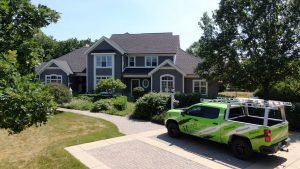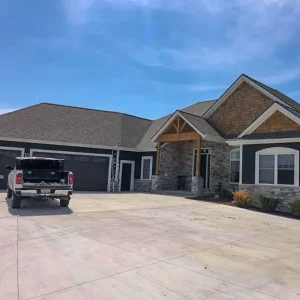When homeowners ask us about replacing windows, the conversation quickly moves past just “glass.” You’re weighing insulation performance, durability, condensation issues, and of course, cost. In Wisconsin, where summers can hit 90 °F and winters dip well below zero, the type of window glass you install can make a big difference.
This article breaks down the essential layers of a modern window system, from pane count to gas fills, and helps you understand how each choice affects comfort, efficiency, and long-term maintenance. At Heins Contracting, we’ve installed thousands of windows across the state and have seen firsthand what works, what doesn’t, and why.
It’s Not Just About Glass — It’s a Whole System
We’ve seen plenty of homes where the glass wasn’t the problem, it was the frame, the spacer, or poor installation. A window is a sealed unit, and every layer plays a role. Triple-pane windows sound like an upgrade, but they’re not always the right fit for your home. Similarly, Low‑E coatings can help reduce heat loss, but in the wrong orientation, they might actually block passive warmth in winter.
Reality check: Some triple-pane windows lose their gas fills in under 10 years because of poor seal construction, and that makes them no better than a standard double-pane.
Warning: Just adding a more expensive window won’t fix drafts if your attic lacks insulation or your sills aren’t properly flashed.
Picking the Right Pane: Double vs. Triple
Double-pane basics and where they still work
Most existing homes in Wisconsin have double-pane windows, and for good reason. With two layers of glass and an insulating space between, they offer decent thermal protection, especially when filled with argon gas. These windows typically rate between R-3 and R-3.8, depending on whether they have Low‑E coatings.
On average, double-pane replacements run about $400–$600 per window installed. For homeowners with decent attic insulation and weatherized exteriors, this setup often performs just fine, especially on less-exposed sides of the house.
Triple-pane performance in colder zones
Triple-pane windows add a third layer of insulation and can achieve R-values between 5 and 7. That’s a 20–25% increase in thermal efficiency, which makes a real difference in colder months, especially on north and west-facing walls.
However, the added performance comes at a cost: triple-pane windows usually run $150–$250 more per window and add weight, requiring stronger frames and better support.
Reality check: Triple-pane windows can reduce energy bills, but only if the rest of your building envelope, attic, doors, siding, supports it.
What Low‑E Coatings Actually Do
Understanding how they block heat and UV
Low‑E (low-emissivity) coatings reflect infrared heat, helping your home stay cooler in summer and warmer in winter. They also block up to 70% of UV rays, which reduces fading on furniture and flooring.
There are different levels of Low‑E coatings (E1, E2, E3), each with different solar gain and reflectivity rates. The coating is often applied to the second or third interior-facing surface of the glass.
Low‑E in Wisconsin homes: smart or overkill?
In most Wisconsin homes, Low‑E coatings help, especially on windows facing strong sun exposure. But if your home relies on passive solar gain in winter (like from south-facing windows), heavy Low‑E coatings might block that helpful sunlight.
Warning: Overusing Low‑E glass on shaded or north-facing windows can create cold zones in winter and moisture build-up around frames.
Note: Ask your installer which surface the coating is applied to. Placement affects how much heat is reflected in and out.
Gas Fills: What’s Inside Matters
Argon vs. Krypton: Pros, costs, and lifespan
Argon is the most common fill, it’s affordable, safe, and provides decent insulation. It works well in wider gaps like those in double-pane units and lasts about 20 years before starting to dissipate.
Krypton is denser and performs better in the thinner spaces between triple panes. It’s more expensive, and most useful where window thickness is limited but high performance is still needed.
What happens when gas leaks?
Once the gas begins to leak (often through a failed seal), insulation performance drops. You might notice fogging or condensation between panes. Unfortunately, you can’t just “refill” them, the insulated glass unit (IGU) usually needs full replacement.
Pro tip: Ask about the gas retention rating when evaluating window products. A well-rated unit can hold its fill for 25+ years under normal conditions.
What We See in the Field: Wisconsin Homes
Real Wisconsin climate needs
We get harsh winters, humid summers, and everything in between. That means your windows have to handle thermal stress, humidity, and freeze–thaw expansion cycles. In homes near lakes or on farmland, moisture and wind exposure often cause early seal failure, even in newer installs.
Ice dam runoff from unventilated attics can also hit window tops hard, leading to premature deterioration of caulking and frame seals.
Common mistakes with replacements
We’ve had to replace windows that were less than 5 years old, not because the glass was poor quality, but because of installation shortcuts.
- No expanding foam around rough openings
- Spacers misaligned
- Frames not shimmed level
- Low‑E used on all windows without considering orientation
Reality check: Glass technology can only do so much, what matters just as much is how it’s installed.
Warning: A window with perfect specs won’t perform if the installer skips flashing tape or misses sealing the sill plate.
Know When to Spend vs. Save
Not every window in your home needs the highest specs. Prioritize south-facing rooms, living spaces, or bedrooms near noise sources for upgrades like triple-pane or enhanced Low‑E. Utility areas or garages may not need the same level of investment.
Pro tip: If your budget is tight, split your upgrade between attic insulation and key window replacements, you’ll often see more impact overall.
Not Sure Which Glass Is Right for Your Home? Let’s Talk It Through
We’ve walked plenty of Wisconsin homeowners through this decision, and not every house needs the same window in every room. From identifying energy leaks to choosing between glass packages, we’re here to help you make the decision that fits your home, your climate, and your budget.
If you’re unsure whether double‑pane is enough or if it’s time to step up to triple‑pane with Krypton and Low‑E, we’ll walk you through it, minus the pressure or fluff.
FAQs
What’s the average cost difference between double-pane and triple-pane windows?
Most triple-pane windows cost $150–$250 more per window installed. For a home with 15–20 windows, that could mean $3,000–$5,000 in added cost.
How long do Low‑E coatings last?
They’re typically sealed between panes and can last as long as the window does, usually 20–25 years, if the seal stays intact.
Can you repair a foggy window caused by gas loss?
No, once the seal fails, the insulating gas escapes. You’ll need to replace the insulated glass unit (IGU), which runs $200–$500 depending on size and type.
Does triple-pane glass help with noise?
Yes, the extra layer reduces sound transmission. Combined with tight seals and quality frames, it makes a noticeable difference, especially near roads or rail lines.




